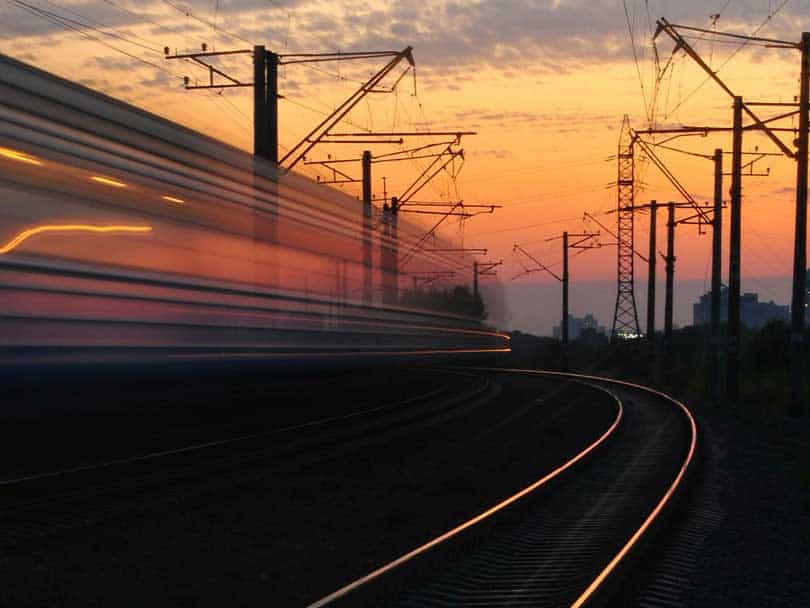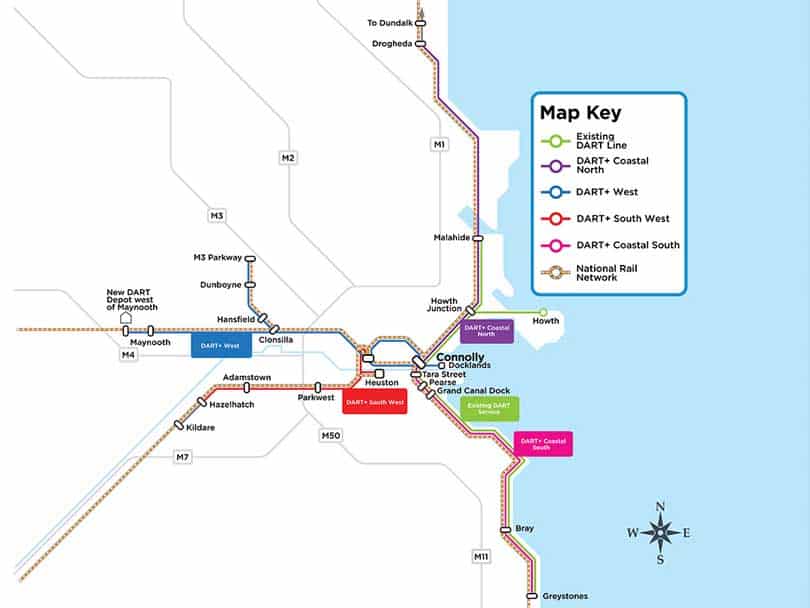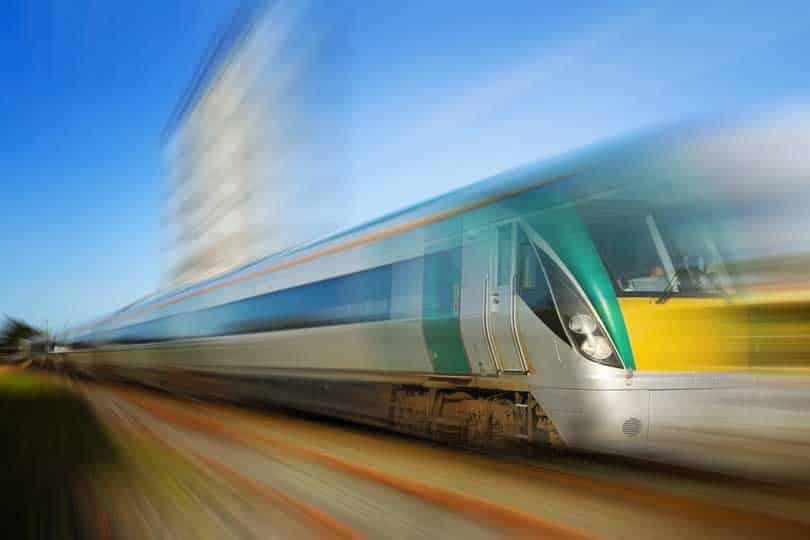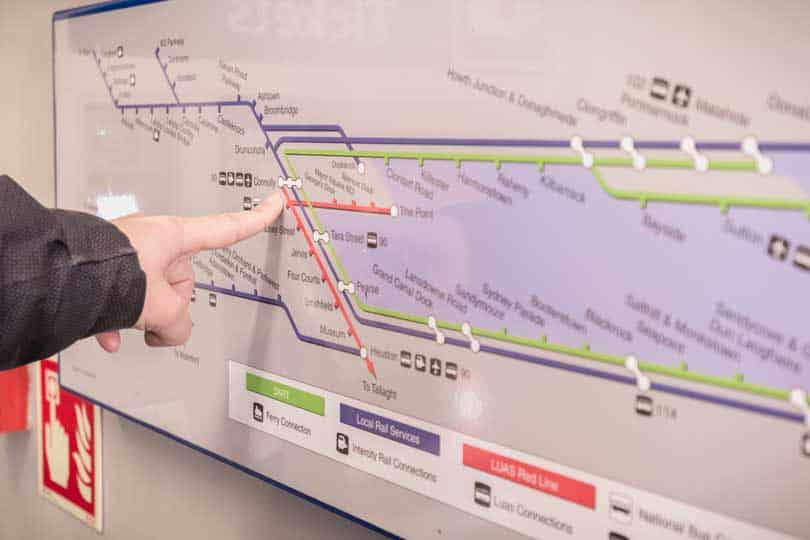What are the specifics of Irish Rail and its planned upgrade works? Our straightforward guide dives into the transformative projects in the pipeline for Ireland’s rail network. Learn about the implications for your travel plans, from speed enhancements to infrastructure refinements, without veering into the unnecessary details.
Key takeaways
- Irish Rail is executing a substantial modernisation plan which includes increasing train speeds, reducing journey times; such as from Dublin to Cork, and expanding and enhancing train services across the country.
- The modernisation and expansion are supported by the National Development Plan, with significant investments into infrastructure upgrades, new trains, collaboration across borders, and initiatives like the DART+ Programme to increase capacity and improve efficiency.
- Environmental sustainability and improved customer experience are central to Irish Rail’s strategy, underscored by the push towards electrification, reducing the carbon footprint, and innovating assistive technologies.
Irish Rail’s ambitious plans for upgrading the rail network
Irish Rail, known as Iarnród Éireann in Ireland, has embarked on an ambitious modernisation journey, aiming to enhance rail services and significantly reduce journey times. Targeting speeds up to 200km/h, the objective is to make rail travel more appealing, thus increasing demand. Imagine whizzing from Dublin to Cork in just 1 hour and 55 minutes! This vision could soon be a reality, thanks to Irish Rail’s strategic improvement works.
Improvements encompassing fleet maintenance, support, and operational delivery, are integral to a comprehensive strategy. The transformation journey is well underway, buckle up as we delve deeper into Irish Rail’s exciting plans for the future.
National Development Plan
The National Development Plan supports Irish Rail’s strategic objectives, including the DART+ Programme and the Cork Area Commuter Rail project, under the Project Ireland 2040 initiative. This endorsement from the National Transport Authority’s Transport Strategy for the Greater Dublin Area 2016-2035 is a testament to the Irish Government’s commitment to improving national rail services.
Awarded to Irish Rail in December 2019, this ten-year contract serves as a robust foundation for the rail network. It marks the beginning of a strategic partnership with the National Transport Authority, promising a reliable, efficient, and sustainable rail network for the whole country.
Investment in infrastructure
Irish Rail is making an unprecedented investment to bolster its railway network. The focus is on enhancing capacity, resilience, and safety across the system. This includes:
- removal or upgrading of seven level crossings along the Cork to Dublin line
- increasing service frequency
- ensuring smoother, more reliable rail travel for all
The investment also extends to cross-border cooperation. Working hand in hand with the Department for Infrastructure in Northern Ireland and the Department of Transport in the Republic of Ireland, Irish Rail is set to provide new trains and an improved hourly service between Belfast and Dublin, thanks to a record investment. And let’s not forget the freight services. With an anticipated increase of up to five times the current levels, the efficiency of sea ports is set to rocket while reducing the number of trucks on the roads.

Enhancing rail services with new trains and upgrades
As part of its upgrade plan, Irish Rail is all set to bring in new trains and upgrades to its existing fleet. By the end of the decade, the current Enterprise train fleet will be replaced with eight new trains. The introduction of these new trains, coupled with increased capacity, will not only enhance journey times but also significantly improve the passenger experience.
In 2023, Irish Rail introduced new carriages, which expanded the capacity of existing diesel intercity multiple unit trains by a significant 20%. These new carriages and improved train services are not just about increasing capacity; they’re about transforming the rail travel experience in Ireland. From faster journey times to more frequent services, rail travel is has become a more appealing option for everyone.
Cork City and Limerick Junction
Beyond improving services, the Cork City rail upgrade program also aims to support urban growth and alleviate road congestion, particularly in congested corridors. The strategy involves introducing a new 95-carriage fleet, enhancing capacity, and redistributing existing carriages to improve other commuter and intercity services.
Meanwhile, Limerick Junction is also seeing significant improvements along its rail line. The introduction of new carriages, and subsequently new trains, are set to considerably enhance journey times.
Both Cork City and Limerick Junction are perfect examples of how Irish Rail’s upgrade works are making rail travel faster, more reliable, and more accessible for everyone.
Collaboration with Northern Ireland’s department
Irish Rail’s collaboration with the Irish government and Northern Ireland’s Department for Infrastructure is a testament to the shared commitment to enhancing rail connectivity and services. This cross-border collaboration operates an intercity service that connects Dublin and Belfast, making travel between the Republic of Ireland and Northern Ireland smoother and more efficient.
This partnership showcases how shared goals and mutual cooperation can lead to significant improvements in rail services for benefit of it’s customers. It’s a clear signal that Irish Rail is not only committed to enhancing rail services within its borders but also to improving cross-border connectivity.

Expanding the DART network for greater connectivity
As part of Irish Rail’s development strategy, the DART+ Programme is a €2 billion initiative aimed at:
- expanding and upgrading Dublin’s electric rail network
- more than doubling the commuter capacity
- extending electrification from 50km to over 150km across the Greater Dublin Area network.
Key projects under the DART+ Programme include extending the Northern Line from Malahide to Drogheda and modernising the Kildare Line. These expansions promise to transform travel by connecting new communities and tripling the current DART network coverage.
So, whether you’re commuting to work or exploring the city, the DART+ Programme is all about making travel more convenient and accessible for everyone.
Modal shift and environmental impact
Investments in public transport infrastructure, especially the DART network, aim to catalyse a shift from car usage towards more sustainable public transport alternatives. In the Cork region, upgraded signalling systems are expected to foster this modal shift to trains.
This shift aims not only to enhance public transport but also to promote environmental sustainability. By reducing Dublin’s car modal share from 57.7% to 48.6% between 2016 and 2042, the modal shift is expected to significantly reduce CO2 emissions. It’s not just about getting from point A to point B; it’s about doing it in a way that’s good for the environment.

Improving access and customer experience
At the heart of Irish Rail’s vision is a commitment to creating an integrated, sustainable, and accessible public transport network. The focus is on enhancing accessibility and customer experience, particularly for customers with disabilities.
To assist individuals with disabilities, Irish Rail is developing and trialling new accessibility initiatives such as WelcoMe and NaviLens technology. These ground-breaking initiatives enable customers to communicate their assistance requirements to station staff beforehand and aid visually impaired customers in navigating train carriages. Furthermore, Free Travel Pass holders can now reserve seats on InterCity services online with no fee, enhancing their travel experience and access to Irish Rail services.
Partnership with National Transport Authority
Supported by a collaborative partnership with the National Transport Authority, Irish Rail is dedicated to improving accessibility and enhancing customer experience. This partnership ensures that consistent accessibility standards are upheld, delivering quality service to all passengers, including those with disabilities.
But the partnership doesn’t stop there. Irish Rail also collaborates with organisations representing people with disabilities to further improve accessibility across the rail network and its stations. It’s about creating a rail network that’s accessible and comfortable for everyone.
Staff training and onboard amenities
Irish Rail places a high emphasis on staff training to improve accessibility onboard. By equipping staff with the necessary skills and knowledge, Irish Rail aims to provide an enhanced experience for all customers.
Feedback from passengers with disabilities is actively solicited by Irish Rail to make continuous improvements in accessibility features and customer service. It’s about listening to customers, understanding their needs, and making the necessary improvements to ensure everyone has a comfortable and enjoyable journey.
Advanced technologies for efficient railway operations
Irish Rail is embracing the future with the adoption of advanced technologies for efficient railway operations. These technological advancements include the construction of a single Network Train Control Centre and the retrofitting of the current operational fleet with ETCS Level 1 technology.
These technological advancements aim not only to improve efficiency but also to ensure safety and reliability. With the National Transport Authority outlining specific standards for punctuality, reliability, and customer service, Irish Rail is committed to upholding these standards and delivering a top-notch service to all passengers.
Signalling and train control systems
As part of its upgrade works, Irish Rail is adopting the following technologies to enhance safety and capacity on the rail network:
- European Train Control System (ETCS) Level 1
- Alstom and Egis partnership to implement ETCS and Smartlock systems and modernise signals and communications
- Hacon TPS train planning software
It’s about leveraging the best technologies to deliver the best services.
Remote diagnostics and predictive maintenance
Irish Rail has introduced the Nexala R2M system, a train remote diagnostics platform that allows for management of onboard systems and early detection of potential issues across various fleet types. With the advanced version of the diagnostics system, R3M, Irish Rail is focusing on predictive diagnostics, further enhancing its maintenance capabilities.
By implementing Trimble R2M analytics, Irish Rail is transitioning to condition-based maintenance, identifying component health and behavior anomalies. This approach reduces maintenance costs and improves mean time between faults.
Moreover, automated inspection systems provided by Wabtec Track IQ are employed for regular, accurate assessments of wheel and axle bearings, supporting the maintenance and safety of Irish Rail’s fleet.

The future of rail in Ireland: electrification and expansion
With a commitment to a long-term vision of a fully electrified railway network, Irish Rail is looking towards the future. This vision plays a crucial role in the country’s sustainability objectives. By 2030, Irish Rail aims to have a significant proportion of the network operating on electric and battery-electric trains, reducing reliance on diesel locomotives.
Irish Rail’s plans extend beyond this. The expansion and modernisation of the rail network is another area of focus. This includes the development of new lines and enhancements of existing services, catering to increased urbanisation and population changes. Significant investment is also being directed towards constructing new stations, which contributes to the accessibility and attractiveness of rail travel.
Electrification strategy
Irish Rail’s strategy, which includes decarbonisation as an integral part, aims to reduce the carbon footprint through the operation of electric and battery train (BEMU). The first order of 95 electrically-powered carriages, set to roll out starting from 2025, signals the start of the electrification project.
Envisioning a significant transformation of its operations, Irish Rail plans to incorporate up to 600 electric or battery-electric carriages into its rolling stock. These new carriages include hybrid electric/battery-electric capabilities, allowing them to operate even beyond electrified track sections. A clear signal that Irish Rail is committed to achieving national decarbonisation goals.
Expanding rail lines and services
Expanding rail lines and services is a priority for Irish Rail. This includes:
- reducing journey times on major intercity routes
- objectives to cut travel time to under two hours for Cork-Dublin
- objectives to cut travel time to around one hour and 45 minutes for Limerick-Dublin within five years.
In response to growing population and the need for expanded network services, two new rail stations are scheduled to open: Kishoge Station in summer 2024 and Woodbrook Station in 2025. Moreover, the Ceannt Station in Galway is undergoing a significant redevelopment to become an integrated transport hub, enhancing regional connectivity and service quality.
Summary
In conclusion, Irish Rail is embarking on an ambitious journey of transformation. From upgrading its rail network to enhancing rail services, expanding the DART+ network, improving access and customer experience, to adopting advanced technologies for efficient railway operations, Irish Rail is charting a course for a future where rail travel is faster, safer, and more efficient. With plans for electrification and expansion, the future of rail in Ireland looks bright. So, are you ready to be a part of this exciting journey?
Frequently asked questions
What is Irish Rail’s vision for the future?
Irish Rail’s vision for the future includes enhancing rail services, reducing journey times, and increasing capacity across all lines. It also plans to fully electrify the railway network by 2030, in line with the country’s sustainability goals.
How is Irish Rail upgrading its rail network?
Irish Rail is upgrading its rail network by investing in infrastructure improvements, such as line improvement works and the adoption of advanced technologies like the European Train Control System. This will lead to a more efficient and modernised railway system.
What is the purpose of the DART+ Programme?
The purpose of the DART+ Programme is to expand and upgrade Dublin’s electric rail network, increasing commuter capacity and extending electrification over the Greater Dublin Area network from 50km to over 150km by completion.
How is Irish Rail improving accessibility and customer experience?
Irish Rail is improving accessibility and customer experience by providing staff training, introducing new accessibility initiatives, and partnering with the National Transport Authority to maintain consistent accessibility standards. These efforts are particularly beneficial for customers with disabilities.
What is Irish Rail’s electrification strategy?
Irish Rail plans to introduce electric and battery-electric trains by 2030 to reduce reliance on diesel locomotives as part of its decarbonisation strategy.

